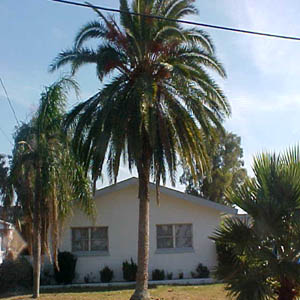Date Palm Cultivation: Creating a Microclimate
June 14th, 2008 · 1 Comment · Tree, by plant, garden plants

Date Palm is a traditional crop and during past few decades, it has gained acceptance in more than 40 countries around the world including the United States, South Africa, and Australia. Among the major importers of the date palm are India, United Arab Emirates (UAE), Pakistan, and Malaysia.
Date Palm has an important role to play in the process of de-desertification as a valuable plant agent. With its typical growth structure and climatic acclimatization, it helps in creating a specific micro-climatic zone, which is unique in its own way. Several other plant species find suitable growing conditions under this microclimate. These plant species survive in the mottled sunshine under the date palm tree. The direct sunlight penetrates through the high canopy of the date palm and provides a lifeline to these different species.
This penetration of sunlight through the canopy creates a particular shade-house-effect that helps immensely in reducing the rate of evapotranspiration. This effect also increases the rate of humidity considerably and because of this, a different secondary food production system is established. This system also introduces and includes several other plant species.
The moderate winter temperature and a long, hot, and dry summer climatic conditions are more favourable for the growth and cultivation of the date palm. With its normal growth pattern, a typical date palm plant can produce 10-20 off shoots and each of such off shoot may be around 15 kg in size and weight when the plant is four to ten years in age. After this critical age of ten years, the plant cannot produce any off shoots like this.
Date palm fruits constitute a major worldwide production trends. Every year almost 5.4 metric tonnes date palm fruits are produced globally. Egypt, Iran, Saudi Arabia, Pakistan, and Iraq are five biggest date palm fruits producing countries of the world.
Date palm fruits are rich in the iron, potassium, and calcium contents. These fruits are highly delicious and are rich source of natural sugar. Almost 70-75% of the total content of these fruits is sugar. It is a real rich source of energy .One kilogram of the date palm fruits will produce almost 3,000 calories of energy.
Recent researches have been able to create genetically advanced hybrid varieties of date palm. In the countries where date palm is grown extensively you may easily locate high-tech date palm farms. These farms are producing high quality date palm plants for international markets. Genetically engineered secondary hardened tissue culture raised date palm plants more suitable for direct transplanting in to the fields.
Unfortunately, there does not exist any fast multiplication technique that can facilitate the extension and coverage of more area under the date palm cultivation at a faster pace.
No comments:
Post a Comment